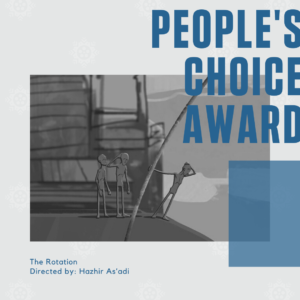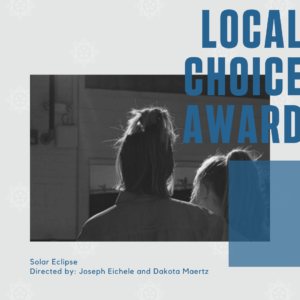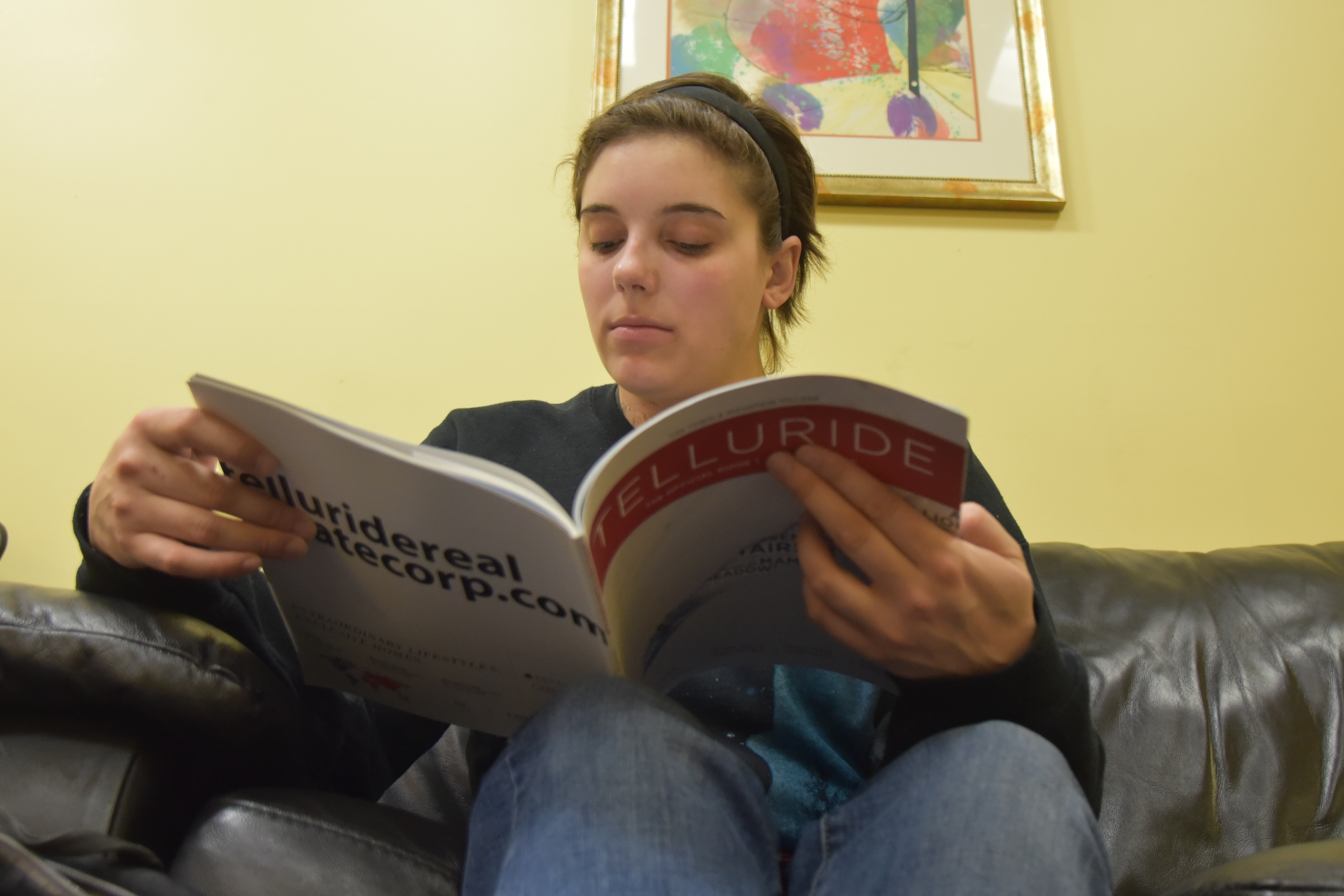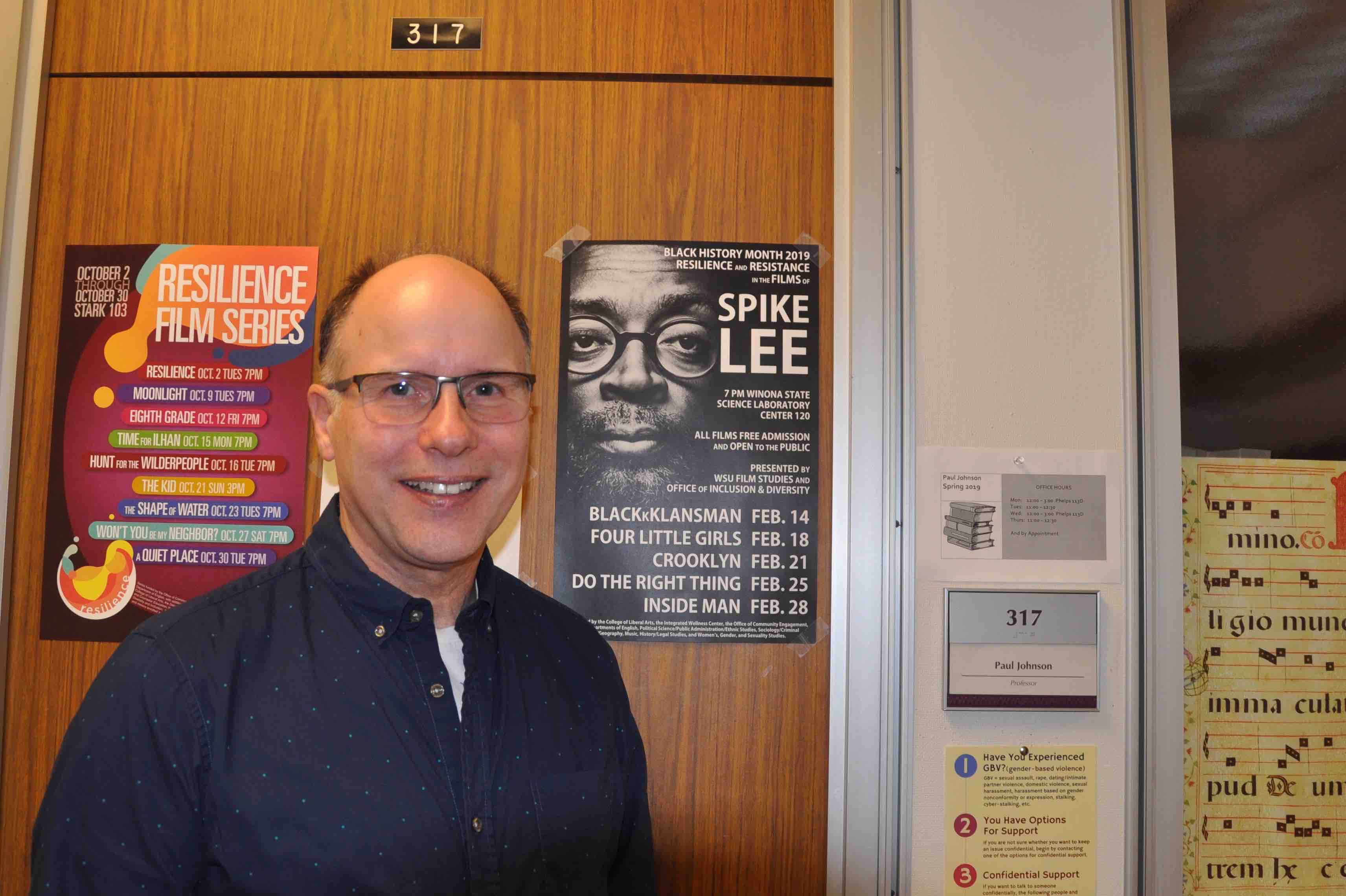Audio slideshow by Greg Off
Audio slideshow by Greg Off
The Frozen River Film Festival is a year-round program in Winona that showcases the art of documentary film, which happens every February of the year. The festival’s mission is to engage, educate, and activate the community to become involved in the world. Some films may not be available through other media, making them special for providing a unique perspective on environmental issues, sustainable communities, sports, adventure travel, and diverse cultures.
Before the COVID-19 pandemic, the FRFF happened face-to-face with workshops and forums. This year it was all virtual via on-demand streaming. The FRFF group believes their filmmaking workshops and forums inspire local filmmakers to improve their craft. These types of events often feature world-class filmmakers who share skills and inspiration to the public, providing a learning opportunity from each other.
The documentary films feature exciting stories, interviews, and various perspectives on current affairs. The films encourage the public to learn more about an issue, volunteer with an organization, and help financially support a cause they believe.
Eileen Moeller, managing director of the FRFF, explained the festival was created by members of Theatre du Mississippi as an annual event where volunteers brought sets from Mountainfilm Festival in Telluride to Winona.
“There was an interest in documentary films and by collaborating with an existing film festival, volunteers were able to bring exceptional documentary film programming to Winona,” said Moeller.
The event was popular and eventually took on a life of its own and was able to become a separate entity from Theatre du Mississippi.
This was the Festival’s 16th year. Over recent years, the organization has worked to expand beyond the usual one-week festival and offer more throughout the year.
Moeller said the virtual festival was a success and a great way to reach people in a way that felt comfortable, safe and accessible. For her, the big difference this year, besides being online, was that people were able to see far more films than they typically would on a weekend, as there was more time to watch them.

The FRFF partners with Winona State University and its students. “We had great engagement from students this year, but we always hope for more, especially since this event happens on the WSU campus and students can get in for free” said Moeller
According to Moeller, the process for the 2022 festival has already begun. The film submissions opened on Feb. 15. Already, seven films have been submitted. Those will be reviewed and as more films get submitted, they will continue to review them and start to brainstorm.
J Paul Johnson, a film studies professor at Winona State University, attended the FRFF regularly since its beginning and partnered with the festival for years. Besides introducing films and supervising internships, Johnson served as a jury member both this year and others.
Johnson said he thinks the Frozen River Film Festival is a boon to the artistic, creative and social community of Southeast Minnesota and Winona State students. According to him, WSU film studies majors and minors volunteer at and intern with the festival, and this year, seven students had their work featured in the festival.

Johnson’s advice to students is to take a chance and enjoy the films.
“Let the films show you what they do,” said Johnson. “Every one of them will have its own charm and purpose, whether short or feature-length, local or global, small-scale or epic. You won’t be disappointed!”
The FRFF group misses gathering together with the public, but as Moeller says, the “warmth of Winona” is not always about being in the same space together.
For more information visit https://www.frff.org/
Having the same conversation over and over can be tiresome, especially when you’re talking in circles.
One of the most common debates in sports is, “Moss is better than Rice,” or vice versa, and it usually gets nowhere.
That’s why in 2014, Garret Greenlee created a Twitter and YouTube channel where he could prove his sports-related thoughts through facts.
“I got sick of having the same conversation with people like, ‘man this guy’s good, or this guy’s good,’” Greenlee said. “I just created an account and thought whatever happens, happens.”
The accounts grew rapidly.
After four years, Greenlee’s Best NFL Matchups had more than 20,000 followers on Twitter.
Only problem was, he had no idea what email he used when he made the account.
“I was following people way too fast, so Twitter thought I was a spam account,” Greenlee said. “They sent an email to the account I had with it, but I had no idea what that email was, and I lost the account forever.”
Greenlee had to start all over.
Lucky for him, he had a couple friends with similar accounts, and they gave him a shout out to help build his new channel, Football Analysis.
“I only have 1,500 subscribers on YouTube right now. Not ‘only,’ like I’m grateful for them, but I want to get to the point where I’m at 30, 40, 50, 100 thousand subscribers and do a giveaway once a month of a signed whatever,” Greenlee said. “I do appreciate the support, but I want to get to a point where I can use this as a side income just for talking about what I love, which is football.”

How does Greenlee make money with these videos?
“You have to have 1,000 subscribers,” Greenlee said. “But within the past year, you also have to have four thousand watch hours of your content. So that took a little bit to build up.”
Four thousand hours may seem like a lot, but with browse features, you can reach more people than just your subscribers, which happened to Greenlee a few times.
“I have a couple with 30 thousand, 20 thousand views and that really gets a lot of the hours at almost the snap of your fingers,” Greenlee said. “So, in reality you could have one video that has 60 or 100 thousand views, and you get your four thousand hours, then the rest of your videos combined could have only 500 views.”
Since the interview, Greenlee has reached the 2,000-subscriber mark with his new account.
The content is starting to pay off.
He explains this in the video.
Andy Carlson, a Winona State graduate and creator of the Purple FTW! podcast, said a Vikings vs Ravens blizzard game in 2013 sparked his interest in talking sports.
Carlson looks at all the players on the Vikings roster and analyzes the national media coverage of the Vikings, while adding his own twist of humor for his 23,000 subscribers.
“There will always be a market for fan content,” Carlson said. “People want niched down perspective over national media jabronis.”
Here is a clip from a recent video.
With this being his side job, Carlson said he always finds the motivation to release numerous videos a day.
“The viewers who continue to make us part of their day (motivates me),” Carlson said. “If we can be a nice little five minute break from life and give some info and some entertainment. Worth it.”
Carlson offers monthly memberships for $4.99 and $24.99 on his YouTube channel that offers extra benefits such as one-on-one chats and free merchandise.
Teespring has teamed up with Carlson and Purple FTW! to sell this merchandise that includes t-shirts, mugs and stickers.

“It’s a very decent side hustle,” Carlson said. “Merch is fun, and everything helps keep the production lights on.”
With the quarantine giving people more free time than ever, podcasts and YouTube may be a good pass time to listen to, or maybe even try.
Football Analysis Link
https://www.youtube.com/channel/UCjoHPnySKcDbxzaF2R8YM2Q
Purple FTW! Link
In the week leading up to and including Memorial Day weekend, Winona State University’s film studies department will be hosting a travel-study in which students are given an opportunity to visit Telluride, Colorado, and experience the annual Mountainfilm Film Festival.
Not to be confused with the town’s other film festival, the aptly-named Telluride Film Festival, Mountainfilm is documentary-based, curating nonfiction stories that explore topics like the environment, culture, recreation, political and social justice issues and more.
This will be the second year in a row for the travel-study.

Johnson said a festival like Mountainfilm provides attendees with a chance to see a breadth of career opportunities.
“Novice-level understanding of film is typically predicated on people being aware of … somebody who’s hitting the headlines with big breakout blockbuster films …,” Johnson said. “What many people don’t understand … is that there are thousands and thousands of jobs in this industry at all levels …”
According to Johnson, Mountainfilm teaches people that film jobs burrow deeper than what is displayed on a teaser poster.
“There are people who are deeply invested in and working hard at the production of films,” Johnson said, listing grips, gaffers and sound technicians as examples, while also adding there are jobs in filmmaking that do not “necessarily involve being the director of ‘Avengers: Endgame’ or ‘Black Panther.’”
Another important concept students learn is even the best in the industry start at the bottom.
This concept was amplified during the 2018 travel-study to Mountainfilm when students had a chance-meeting with Barry Jenkins, director of the 2017 Academy Award winner for Best Picture “Moonlight.”
Johnson said Jenkins, like all students of film, started at the bottom and worked his way up.
“He remembered very well being at the start of his career,” Johnson said. “He remembered getting to go to a film festival for the first time, getting to meet a few directors, going up to a couple of others, tapping them on the shoulder, asking if he could have a minute of their time. He was superbly gracious with students and talking about that.”
Johnson said he believes those who attended the 2018 travel-study returned with a greater appreciation for filmmaking.
“I guarantee students came back awed … by that experience and really motivated by it,” Johnson said. “I think if you talk to any of them who went there last year, I’m pretty confident that that is what they’ll say.”
Film student Brynn Artley, a sophomore who took the travel-study in 2018, agreed with Johnson.
“I had a ton of fun, highly recommend the trip,” Artley said. “We saw a ton of different films in the span of three or four days. We wrote up reviews, we made blogs about it. It was just a lot of fun.”
While any student can register for the course, Johnson said film majors and minors are ultimately given precedence over others.
“We have a built-in selection system, in that it requires a 2.5 GPA,” Johnson said. “We do give priority to declared film studies majors and minors.”
Johnson added a vetting process would only take place if the course had more students than necessary.
Twelve are enrolled.
“We rank and evaluate applicants if we have more than 20,” Johnson said. “I would not at all be displeased if we had so many people wishing to go on this program that we had to make those kinds of decisions. That would be a good problem to have. But right now … I’m pretty comfortable with where we’re at.”
A caveat of the travel-study is the price.
Despite her taking the travel-study this year, Brittany Bluhm, a senior double majoring in English writing and film studies, discussed her past financial constraints and how they kept her from taking the course and attending the festival last year.
“I was hung up on rent and a lot of medical bills,” Bluhm said. “I was like, ‘There’s no way I can come up with $500 (the confirmation deposit) to stash toward the trip.’”

According to the brochure for 2020’s travel-study to Telluride, the cost fluctuates around $3,000, which includes tuition and student fees for the three credits linked to the program, as well as roundtrip airfare, transportation during the program, lodging, breakfasts and dinners, admission and event fees for all educational activities and the Study Abroad administrative fee.
The price is discounted, as well, as Bluhm said students taking the course will be volunteering with film screenings and other activities.
While she was unable to go last year, Bluhm said she understood the reasoning for the price.
“I think, because our film program is relatively new, I can understand why it’s maybe a little bit more expensive,” Bluhm said. “I anticipate the school will contribute more in the future as long as this trip keeps on going.”
According to Johnson, while more people would logically bring the price down, that would also mean jeopardizing the level of attention he is able to give in his instruction for the course.
“The price—the bottom line for the trip—would go down if we had 20 people instead of 12,” Johnson said. “I wouldn’t be opposed to having 16 students or even 20 as the cap … but it would be a different experience for me, a more complex one, and I don’t know if my students would get the individual attention that I know they will get with 12.”
Johnson said the price of the travel-study is lower than other travel-studies offered by the school.
“Any travel-study is an expense,” Johnson said. “Our travel-study to Mountainfilm is about half the expense or less than any of the international studies … Normally to travel abroad, earn three credits, over a period of one to two weeks, it is going to set a student back probably about $6,000. The price for our students, including the tuition, air travel, lodging, festival expenses, etcetera, is about $2,600.”
Johnson said he and co-leader Hegge do everything they can to keep the expenses as minimal as possible.
“That’s why, for instance, I cook,” Johnson said. “Because it’s a lot cheaper than having people eat-out in what is kind of a Tony-resort town where prices for that kind of thing are expensive.”
Cost aside, Johnson said he was satisfied with last year’s study and said he hopes this year’s is a repeat.
“There’s not really anything that we aim to do differently this coming year than we did last year,” Johnson said. “We just hope to replicate what we’ve done. It is a really nice experience for students to be able to do this … We have a really good partnership with Mountainfilm, and it’s a great destination for people to be at.”
Until recently, photographs, video, and audio were considered a trusted form of communication and storytelling.
Then, photo editing technology and software was developed and photos were no longer considered to be fully trusted.
Some photographs have been altered so well it’s almost impossible to tell.
But videos can’t be faked, right? Wrong.
New technology is proving that to be false.
Deep fake technology has been developed to superimpose someone’s face onto another’s.
According to the computer science department chair at Winona State University, Mingrui Zhang, the idea behind the technology has been around for more than ten years.
It’s mostly been used for entertainment purposes such as the popular children’s movie Toy Story.
“It uses generative adversarial network (GAN) which is based on neural network algorithms,” Zhang said. “It is like any unsupervised neural network it learns from the subjects.”
According to a research paper by Robert Chesney, a professor at the University of Texas School of Law, and Danielle Citron, a professor at the University of Maryland Francis King Carey School of Law, “Harmful lies are nothing new. But the ability to distort reality has taken an exponential leap forward with ‘deep fake’ technology. This capability makes it possible to create audio and video of real people saying and doing things they never said or did.”
This technology could pose as a threat to privacy and security, according to Zhang.
“It may bring up legal and ethical concerns,” Zhang said. “Those are also what computing education society is facing. The social implication of technology,”
Much like on the social media app, Snapchat, there is a feature that maps out a user’s face and can put photos of friends faces or other filters onto a user’s face.
Snapchat is similar to deep fake technology. Flaws can be detected rather quickly and the users can tell it isn’t someone else.
With deep fake technology, it is more complex but the results are better.
“For example, you want actor B to behave like actor A,” Zhang said. “You take video of actor A, the software will analyze the video and construct the skeleton of A, and A’s motion. In filming, wrapping the skeleton of A with the skin of actor B will make the audience think that B is in action. That’s how AVATAR was made, but the process is too expensive for average person. But with help of a machine learning algorithm like GAN, faking is possible for everyone.”
An issue where deep fake technology arose was in the porn industry. Users of the technology were placing celebrities faces onto others in porn videos.
This is an issue of consent and the well-being of those celebrities. They did not give permission to have their faces in those videos.
“Deep fakes make them available to average person. It started for entertainment, could be used to fake someone’s action who has never committed,” Zhang said.
Chesney and Citron wrote more on the effects of deep fakes.
“Deep fakes have characteristics that ensure their spread beyond corporate or academic circles. For better or worse, deep-fake technology will diffuse and democratize rapidly,” wrote Chesney and Citron. “. . . technologies—even dangerous ones—tend to diffuse over time.”
With that in mind, the porn industry may not be the only industry that is affected as it is hard to contain this type of technology.
Chesney and Citron also wrote about how deep fake technology could affect journalism.
“Media entities may grow less willing to take risks in that environment, or at least less willing to do so in timely fashion,” wrote Chesney and Citron. “Without a quick and reliable way to authenticate video and audio, the press may find it difficult to fulfill its ethical and moral obligation to spread truth.”
Video posted on YouTube by: Bloomberg
With Black History Month underway, Winona State University’s Film Studies will be partnering with the Department of Inclusion and Diversity to sponsor a film series showcasing select films by filmmaker Spike Lee.
The series, titled “Resilience & Resistance: The Films of Spike Lee,” begins at 7 p.m. on Thursday, Feb. 14, with the Academy Award-nominated feature for Best Picture and Best Director “BlacKkKlansman”.
Winona State English and film professor J Paul Johnson, whose course “Directors/Stars: Spike Lee” will be curating the series, commented on the reasoning behind choosing specifically Lee for a film series.

“We want to celebrate Black History Month by looking at the career and accomplishments of one of the most celebrated, important and influential of all African American filmmakers across the 20th and 21st centuries,” Johnson said. “(Lee’s) work is especially timely given the success of ‘BlacKkKlansman.”
The films selected in addition to “BlacKkKlansman”—“Four Little Girls,” “Crooklyn,” “Do the Right Thing” and “Inside Man”—are, as Johnson describes, meant to showcase the range of Lee’s career, spanning from his political works like “BlacKkKlansman” and “Do the Right Thing,” to his exercise in mainstream thriller filmmaking with “Inside Man.”
“Lee really has a strong body of work,” Johnson said. “And that’s something that can hold up a whole film series.”
Talks for the series began shortly after the hiring of Inclusion and Diversity director Jonathan Locust, who Johnson was interested in partnering on programming for the school upon meeting him.
Regarding his thoughts on the series, Locust expressed excitement at the prospect of Lee being the subject matter of an entire film series.
“Spike Lee (is) one of my favorite directors, he’s also produced some of my favorite movies I grew up with,” Locust said.
Locust expressed excitement in regards to the partnership between Inclusion and Diversity and Film Studies.
“Finding out there was a class being taught (on Lee), and being asked to collaborate, it just made sense,” Locust said. “These are the types of things that Inclusion and Diversity wants to be involved in.”
Locust said the range of the films selected will help identify with a diverse audience.
“No matter who you are, you should be able to find something,” Locust said. “Even though the films are being shown during Black History Month, these aren’t necessarily Black History Month films.”
In regards to the purpose of the series, Johnson commented on the lack of showings for Spike Lee films in Winona.
“I think it would be great if our community could have the opportunity to take a look at once again and celebrate the incredible work he has done over his career,” Johnson said.
Locust himself voiced a lesson audiences should take away from the series as whole.
“I think there is a common perception that everybody in the industry is just white,” Locust said. “… it’s important for people to see that there are films being made by under-represented groups.”
Even though this series is the only planned partnership between the two groups, both Johnson and Locust expressed interest for Inclusion and Diversity and Film Studies to collaborate again in the future.
“I hope Film Studies can keep partnering with Inclusion and Diversity on either Black History Month programming or Women’s History Month programming in the future,” Johnson said. “That could be a pretty exciting avenue for us.”
As for Locust, he referred to one of the objectives of Inclusion and Diversity as the compass for a future partnership.
“The goal is you want to try to meet as many people and engulf yourself in different cultures,” Locust said. “We want to continue having the film series and working with Dr. Johnson and other faculty and asking, ‘Who are other directors we need to be looking at?”
In addition to “BlacKkKlansman,” the subsequent films in “Resilience & Resistance: The Films of Spike Lee” will be showing every Monday and Thursday at 7 p.m., respectively, until the end of February in the auditorium of Winona State’s Science Laboratory Center. All film admissions are free and open to the public.